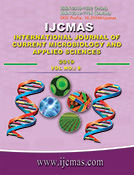


 National Academy of Agricultural Sciences (NAAS)
National Academy of Agricultural Sciences (NAAS)

|
PRINT ISSN : 2319-7692
Online ISSN : 2319-7706 Issues : 12 per year Publisher : Excellent Publishers Email : editorijcmas@gmail.com / submit@ijcmas.com Editor-in-chief: Dr.M.Prakash Index Copernicus ICV 2018: 95.39 NAAS RATING 2020: 5.38 |
India is recognized as a significant producer of orchids in the world. Nearly 1300 species of orchids are found in India which constitutes almost 10 percent of the world orchid flora with Himalayas as their main home (Medhi and Chakrabati, 2009). Orchids are amongst the most advanced flowering plants, highly specialized in many ways. They are distributed all over the world except the Antarctica (Ali and Mir, 2013). Orchid seeds are almost microscopic in size and almost 400 years ago, when orchid seeds were first seen and the development of a practical asymbiotic method for their germination by Knudson in 1921. Thereafter, orchid growing and hybridization became widespread. Hybrids that early growers could not even have imagined became possible (Wing and Arditti, 2009). In vitro cultures of orchid seeds have shown that different species require different and often specific medium composition for optimum germination and growth. To overcome these problems some have suggested the development of optimized asymbiotic seed germination methods for entire genera or individual species. Asymbiotic orchid seed germination has been used for the production of commercially important orchids and has been shown to be an efficient tool for the production of orchids for conservation and reintroduction purposes (Kauth et al. 2006). In vitro seed germination studies can provide insights into in situ plant responses to environmental conditions and basic information of early plant growth and development. Symbiotic seed germination techniques represent an efficient way to promote the orchid fungus association under in vitro conditions and to study in vitro orchid–mycobiont specificity (Stewart and Kane, 2006).
 |
 |
 |
 |
 |